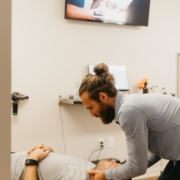What causes a less than optimal functioning nervous system?
The nervous system is designed to control, regulate, and communicate with all the systems of the body. The nervous system receives signals from the internal and external environment, interprets them, and then decides what is best for the body. In order to understand why our nervous system goes into overdrive we first must understand how it works.
This blog is focused on the autonomic nervous system, aka the involuntary system that is half running behind the scenes. This system is broken up into two divisions: parasympathetic and sympathetic. The parasympathetic is “rest and digest” mode while the sympathetic is “fight or flight”. For example, if you were being chased by a bear, the sympathetic would turn on rather if you were meditating on the beach then the parasympathetic would turn on. Both systems are vital to the bodies survival, but should stay mostly in a parasympathetic mode.
Unfortunately, most people today are quite the opposite as they are stuck in sympathetic overdrive. Potential symptoms of sympathetic overdrive can include: headaches, anxiety, lowered immune response, irritability, fatigue, etc.
Why does our nervous system get stuck in this sympathetic response? As chiropractors we like to focus on three root causes: thoughts, traumas, and toxins (3 T’s). Depressive feeling, anxious thoughts, self-limiting, and negative thoughts can cause neurotransmitters to be released that ignite the sympathetics. Trauma, whether physical/mental/emotional can get stored in the body and effect how we process and interpret other incoming stressors. This topic is covered in depth in the book “The body keeps the score” by Van Der Kolk. We are exposed to toxins everyday through our food, water, and air whether it be chemicals, pesticides, harmful electromagnetic frequencies, micro plastics, etc. With more toxins in today’s world than ever seen before, our bodies can’t work fast enough to eliminate them. This puts our body in a constant stressed out state AKA sympathetic overdrive.
What can be done to help regulate your sympathetic nervous system? Chiropractic can help put your body into a parasympathetic state while also reorganizing stored tension. Getting consistent care can give your body a break and allow it to be better adapt to deal with all the various stressors. Another key is to try and eliminate as much of the three T’s as possible. The combination of these two things will give most people a great starting place for maximizing the function of their nervous system.


